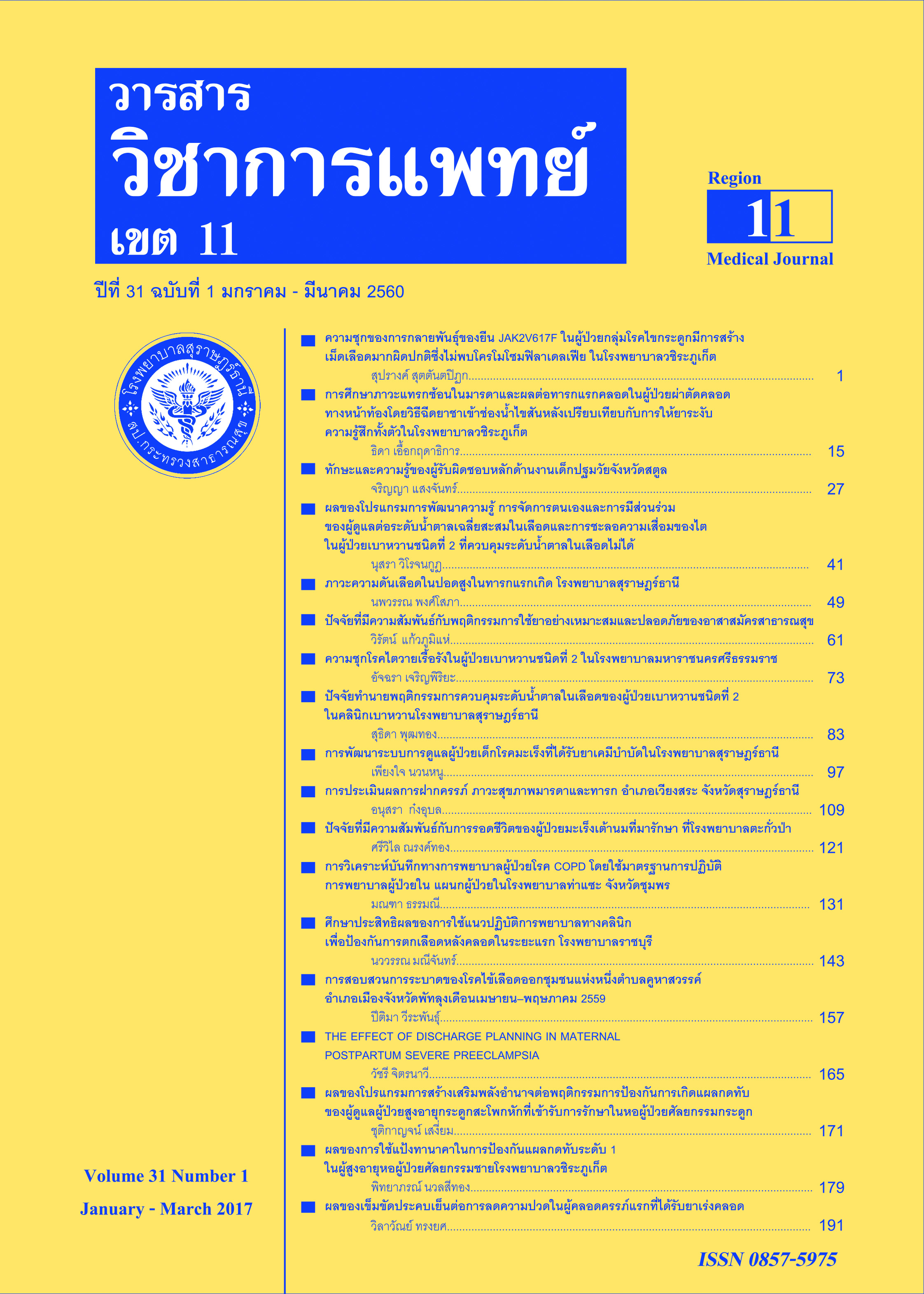Effectiveness of implementing clinical nursing practice guidelines for prevention of early postpartum hemorrhage at Ratchaburi Hospital
Keywords:
clinical nursing practice guidelines (CNPGs) early postpartum hemorrhageAbstract
This comparative,prospective, uncontrolled before and after intervention design was conducted to determine the effectiveness of implementing clinical nursing practice guidelines (CNPGs) for prevention of early postpartum hemorrhage at RatchaburiHospital.The research was carried out from Augest 2016 to December 2016. Samples were divided into 2 groups: 86 parturients who received usual nursing care, and 86 parturient who received care using the CNPGs. The research instruments were: 1) the CNPGs for prevention of early postpartum hemorrhage among mothers in Ratchaburi Hospital, 2) the postpartum hemorrhage recording form. Data were analyzed by using descriptive statistics and the Fisher’s exact probability test.
The results of this study revealed that the parturients in CNPGs implementing group had significantly higher proportions of early postpartum hemorrhage than the parturients who received usual nursing care group( p< .05). For proportion of severity ofpostpartum hemorrhagein CNPGs implementing group had significantly lower than the parturients who received usual nursing care group (p< .05). The results confirm that implementation of CNPGs for prevention of early postpartum hemorrhage can lead to improved quality outcome. So this CNPGs should be used as a routine care for all although there is no risk.
References
2. Carroli G, Cuesta C, Abalos E, Gulmezoglu AM. Epidemiology of postpartum haemorrhage: a systematic review.Best Pract Res ClinObstet Gynaecol;2008;22(6):999-1012.
3. Schorn MN. Measurement of blood loss: review of the literature.Journal ofMidwifery &Womens Health ;2010;55:20–7.
4. Al-Kadri HM, Al-AnaziBK,Tamim HM.Visual estimation versus gravimetric measurement of postpartum blood loss: a prospective cohort study. Archives of Gynecology and Obstetrics; 2011;283(6):1207-1213.
5. World Health Organization [WHO]. Guidelines for the management of postpartum haemorrhageand retained placenta. [online]. 2012. Available from http://whglibdoc who.int/ publication /2009 /9789241-eng.pdf.[ cited 2016 January 20].
6. Weeks A. The prevention and treatment of postpartum haemorrhage: what do we know, and where do we go to next?".International journal of obstetrics and gynaecology;2015;122(2):202-210.
7. กลุ่มพัฒนาระบบบริหาร กรมอนามัย กระทรวงสาธารณสุข. ยุทธศาสตร์ตัวชี้วัดและคำรับรองการปฏิบัติราชการ กรมอนามัย ประจำปีงบประมาณ พ.ศ.2559. [ออนไลน์ ]. 2559. สืบค้นจากhttp://psdg.anamai.moph.go.th/download/D_seminar /seminar6_0159/9 Strategy.pdf.[เข้าถึงเมื่อ 4 พฤษภาคม 2559]
8. Smith J.R. Postpartum hemorrhage. [online].2011. Available from:http://www. emedicine.com/med/ topic 3568.htm.[ cited 2016 January 20].
9. Prata N, Hamza S, Bell S, Karasek D, Vahidnia F, Holston M. et al. Inability to predict postpartum hemorrhage: Insights from Egyptian intervention data [online]. 2011. Available from: http://escholarship. org/uc/item/0b54873d.[cited 2017 January 23].
10. Pillitteri A. Maternal & child health nursing care of the childbearing & childbearing family. 5th ed. Philadelphia: Lippincott Williams &Wikins; 2007.
11. Frolova AI, Stout MJ, Tuuli MG,López JD, Macones GA, Cahill AG.Duration of the third stage of labor and risk of postpartum hemorrhage. Obstetrics & Gynecology;2016 ; 127( 5): 951–956.
12. AndersonJM, EtchesD. Prevention and management of postpartum hemorrhage. American Family Physician ;2007; 75(6): 875–82.
13. Feinberg EC, Molitch ME, Enders LK, Peaceman AM.The incidence of Sheehan’s syndrome after obstetric hemorrhage.American Society for ReproductiveMedicine; 2005; 84(4):975-979.
14. Rossi AC, Lee RH, Chmait RH. Emergency postpartum hysterectomy for uncontrolled postpartum bleeding: A systematic review. J ObstetGynaecol;2010; 115( 3): 637 – 644.
15. World Health Organization (WHO). WHO guidelines for the management of postpartum haemorrhage and retained placenta. Geneva: WHO; 2009.
16. International Federation of Gynecology (FIGO).2012. Prevention and treatment of postpartum hemorrhage in low-resource setting. Int J GynecObstet ;2012; 117: 108-18.
17. Prendiville WJ, Elbourne D, McDonald S. Active versus expectant management in the third stage of labor(Cochrane Review).In : The Cochrane Library, Issue 4. 2007. Chichester.UK : John Wiley & Sons.[online]. Available from:http://apps.who. int/rhl/reviews/langs/CD000007.pdf.[cited 2010May 20].
18. งานห้องคลอด.รายงานข้อมูลตัวชี้วัด. ราชบุรี: โรงพยาบาลราชบุรี;2558.
19. Hofmeyr GJ, Mshweshwe NT, GülmezogluAM. Controlled cord traction for the third stage of labour. Cochrane Database Syst Rev. 2015 Jan 29;1:CD008020. doi: 10.1002/14651858. CD008020.pub2.
20. สภาการพยาบาล. ประกาศสภาการพยาบาลเรื่องมาตรฐานบริการการพยาบาลและการผดุงครรภ์ระดับทุติยภูมิและระดับตติยภูมิ [ออนไลน์ ]. 2548. สืบค้นจาก http://www.tnc.or.th/files/2010/10/act_of_parliament-368/__14975.pdf.[เข้าถึงเมื่อ 20 มีนาคม 2559].
21.บุญชม ศรีสะอาด. การวิจัยเบื้องต้น. พิมพ์ครั้งที่ 2. กรุงเทพฯ : สุวิริยาสาส์น;2535.
22. ชญาณิศวร์ กุณา.การพัฒนาแนวปฏิบัติทางคลินิกสำหรับการป้องกันการตกเลือดหลังคลอดระยะแรกของมารดาในโรงพยาบาลจอมทอง.[วิทยานิพนธ์ปริญญาพยาบาลศาสตรมหาบัณฑิต สาขาวิชาการผดุงครรภ์ขั้นสูง] เชียงใหม่: มหาวิทยาลัยเชียงใหม่; 2552.
23. ฉวีวรรณ ธงชัย, และพิกุลนันทชัยพันธ์. แบบสำรวจความคิดเห็นเกี่ยวกับการใช้แนวปฏิบัติ.เชียงใหม่: คณะพยาบาลศาสตร์มหาวิทยาลัยเชียงใหม่; 2547.
24. National Health and Medical Research Council, Australia [NHMRC].A guide to the development, evaluation and implementation of clinical practice
guidelines. [online].1999. Available from http://www.nhmrc.gov.au/ publications/_files/cp30.pdf. [cited 2016 January 20].
25. จิราณี ปัญญาปิน. ประสิทธิผลของการใช้แนวปฏิบัติทางคลินิกสำหรับการป้องกันการตกเลือดหลังคลอดระยะแรกโรงพยาบาลเชียงแสน จังหวัดเชียงราย.[วิทยานิพนธ์ปริญญาพยาบาลศาสตรมหาบัณฑิต สาขาวิชาการผดุงครรภ์ขั้นสูง] เชียงใหม่: มหาวิทยาลัยเชียงใหม่; 2553.
26. แสงเดือน วงศ์ใหญ่. ประสิทธิผลของการใช้แนวปฏิบัติทางคลินิกสำหรับการป้องกันการตกเลือดหลังคลอดระยะแรกโรงพยาบาลเชียงคำ จังหวัดพะเยา.[วิทยานิพนธ์ปริญญาพยาบาลศาสตรมหาบัณฑิตสาขาวิชาการผดุงครรภ์ขั้นสูง] เชียงใหม่: มหาวิทยาลัยเชียงใหม่; 2553.
27. ธนภร กฤษณาพันธ์. ประสิทธิผลของการใช้แนวปฏิบัติทางคลินิกสำหรับการป้องกันการตกเลือดหลังคลอดระยะแรกโรงพยาบาลพังงา.[วิทยานิพนธ์ปริญญาพยาบาลศาสตรมหาบัณฑิต สาขาวิชาการผดุงครรภ์ขั้นสูง] เชียงใหม่: มหาวิทยาลัยเชียงใหม่; 2553.
28. Bose P, Regan F, Paterson BS. Improving the accuracy of estimated blood loss at obstetric haemorrhage using clinicalreconstructions. J Obstet- Gynaecol ;2006; 113: 919-24.
29. Buckland SS, Homer CS. Estimating blood loss after birth:using simulated clinical examples. Women Birth 2007;20: 85-8.
30. MaslovitzS, Barkai G, Lessing JB, Ziv A, Many A. Improved accuracy of postpartum blood loss estimation as assessed by simulation. ActaObstet- Gyn Scan 2008; 87: 929-34.
31. รสสุคนธ์ จันทร์ดาประดิษฐ์ และสร้อยอนุสรณ์ ธีรกุล. ประสิทธิภาพของการใช้ถุงพลาสติกแผ่นฟิล์มวัดปริมาณการสูญเสียเลือดหลังคลอด.ศรีนครินทร์เวชสาร 2558; 30(3):270-275.
32. สุรีรัตน์ มงคลปทุมรัตน์. ประสิทธิผลของการเร่งคลอดรกในการลดการตกเลือดหลังคลอดระยะแรก วารสารวิชาการสาธารณสุข 2551; 17(5): 737 – 743.
33. โฉมพิลาศ จงสมชัย. ภาวะตกเลือดหลังคลอด. การประชุมวิชาการครั้งที่ 26 ประจำปี 2553. Srinagarind Medical Journal 2010; 25 (suppl): 151-158.






